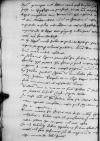Venit huc 25 huius hic Vestrae Reverendissimae Dominationis nuntius ipsoque die litterae distributae sunt. Bona Sforza (*1494 – †1557), Queen of Poland and Grand Duchess of Lithuania (1518-1557); the second wife of Sigismund I Jagiellon; Duchess of Bari and Rossano; daughter of Gian Galeazzo Sforza of Milan and Isabella of Aragon⌊Maiestati reginaliBona Sforza (*1494 – †1557), Queen of Poland and Grand Duchess of Lithuania (1518-1557); the second wife of Sigismund I Jagiellon; Duchess of Bari and Rossano; daughter of Gian Galeazzo Sforza of Milan and Isabella of Aragon⌋ copiam illam cf. Ioannes DANTISCUS to Hendrik III of Nassau-Breda 1537-03-11 — 1537-03-16, CIDTC IDL 6510, letter lost⌊litterarumcf. Ioannes DANTISCUS to Hendrik III of Nassau-Breda 1537-03-11 — 1537-03-16, CIDTC IDL 6510, letter lost⌋ ad Hendrik III of Nassau-Breda (*1483 – †1538), son of Count Johann V of Nassau-Dillenburg and Elisabeth of Hessen, married to Mencia de Mendoza, Marquess of Zenete, daughter and heiress of Rodrigo Díaz de Vivar y Mendoza, first Marquis of Zenete; Count of Nassau; from 1499 in the service of Archduke Philip of Habsburg as his advisor and military commander in the wars against France and Gueders (1507, 1514), 1515-1522 Stadtholder of Holland and Zeeland; 1521 Grand Chamberlain of Charles V of Habsburg (from 1522 to 1529 at the Spanish court), in 1530 followed Charles V to the coronation in Bologna, and attended the Diet of Augsburg (CE, vol. 3, p. 5)⌊dominum de NassawHendrik III of Nassau-Breda (*1483 – †1538), son of Count Johann V of Nassau-Dillenburg and Elisabeth of Hessen, married to Mencia de Mendoza, Marquess of Zenete, daughter and heiress of Rodrigo Díaz de Vivar y Mendoza, first Marquis of Zenete; Count of Nassau; from 1499 in the service of Archduke Philip of Habsburg as his advisor and military commander in the wars against France and Gueders (1507, 1514), 1515-1522 Stadtholder of Holland and Zeeland; 1521 Grand Chamberlain of Charles V of Habsburg (from 1522 to 1529 at the Spanish court), in 1530 followed Charles V to the coronation in Bologna, and attended the Diet of Augsburg (CE, vol. 3, p. 5)⌋ interpretatus sum superinscribed⌈sumsum superinscribed⌉, placuit suae maiestati tanta Vestrae Reverendissimae Dominationis diligentia, hoc tamen ad rem pertinens cupit, ut domino -⌊Georgio Hegel-⌋ scribatur paper damaged⌈[r]r paper damaged⌉, quo habend written over it⌈itendend written over it⌉o litteras ... illegible⌈...... illegible⌉ a domino comite suae maiestati (per me, si libet) legendas offerat, priusquam in Royal Prussia (Prussia Regalis), region, part of Prussia annexed to the Kingdom of Poland in 1466 under the provisions of the Second Peace of Thorn⌊PrussiamRoyal Prussia (Prussia Regalis), region, part of Prussia annexed to the Kingdom of Poland in 1466 under the provisions of the Second Peace of Thorn⌋ Dominationi Vestrae Reverendissimae ferantur, ne mora obsit, ut plerumque solet.
Christianam et paternam Vestrae Reverendissimae Dominationis admonitionem obvio pectore animoque gratissimo accipio, licet, ut verum, quod sentio, dicam superinscribed⌈dicamdicam superinscribed⌉, plus semper crapula quam Aphrodite (Venus), Greek and Roman goddess of love, beauty, and sexuality⌊VenusAphrodite (Venus), Greek and Roman goddess of love, beauty, and sexuality⌋ mihi nocuit, illa enim hanc peperit, utraque autem infirmum corpus facit, primas tamen partes crapulae do, video enim apertis oculis, quo me deduxerit. Ex illa enim capitis mei vertigine secutus est hactenus mirabilis tinnitus in altera aure, cum perpetuo pituitae per nervos defluxu. Non tamen in toto me medicis dedi, solis decoctionibus herbarum loco sirupi usus sum fidens naturae fortiori; consulunt, ut post festa minuam sanguinem. Interim anima, cui Reverendissima Dominatio Vestra consulere videtur plus quam corpori, per veram contritionem curetur.
Melchior, intaglio sculptor ⌊SculptorMelchior, intaglio sculptor ⌋ ille quoque aeger fuit hoc tempore, ob hoc non paravit illa insignia huc usque, verum infra 15 dies promittit fore parata.
 AAWO, AB, D. 4, f. 103v
AAWO, AB, D. 4, f. 103v
Serenissimi Sigismund I Jagiellon (Zygmunt I) (*1467 – †1548), King of Poland and Grand Duke of Lithuania (1506-1548); Duke of Głogów (Glogau) (1499-1506), Duke of Opava (1501-1506), Governor of Silesia (1504-1506); son of King Kazimierz IV Jagiellon and Elisabeth of Austria
Bona Sforza (*1494 – †1557), Queen of Poland and Grand Duchess of Lithuania (1518-1557); the second wife of Sigismund I Jagiellon; Duchess of Bari and Rossano; daughter of Gian Galeazzo Sforza of Milan and Isabella of Aragon⌊principesSigismund I Jagiellon (Zygmunt I) (*1467 – †1548), King of Poland and Grand Duke of Lithuania (1506-1548); Duke of Głogów (Glogau) (1499-1506), Duke of Opava (1501-1506), Governor of Silesia (1504-1506); son of King Kazimierz IV Jagiellon and Elisabeth of Austria
Bona Sforza (*1494 – †1557), Queen of Poland and Grand Duchess of Lithuania (1518-1557); the second wife of Sigismund I Jagiellon; Duchess of Bari and Rossano; daughter of Gian Galeazzo Sforza of Milan and Isabella of Aragon⌋ mei determinarunt post dominicam conductus hidden by binding⌈[ctus]ctus hidden by binding⌉ Paschae in Częstochowa, town in southern Poland, Małopolska⌊CzyestochowoCzęstochowa, town in southern Poland, Małopolska⌋ proficisci, timeo autem ne podagra hidden by binding⌈[ra]ra hidden by binding⌉ regis impediat eam devotionem. Quod si Vestra Reverendissima Dominatio velit hidden by binding⌈[t]t hidden by binding⌉ ad eorum maiestates written over s⌈stestes written over s⌉ mittere nuntium, ut speratur, cum nescio quo hidden by binding⌈[uo]uo hidden by binding⌉ unguento, consulto ordinabitur, ut versus Częstochowa, town in southern Poland, Małopolska⌊Czyestochowo hidden by binding⌈[o]o hidden by binding⌉Częstochowa, town in southern Poland, Małopolska⌋ inquirendo de rege eat, quandoquidem audio parum extra rectam viam fore iter etc.
Dominus Georg Hegel (†1547), the Thurzons' and later the Fuggers' factor in Cracow (worked for the Fuggers at least from 1521); supplier to the royal court in Cracow (PSB 9, p. 336)⌊Georgius HegelGeorg Hegel (†1547), the Thurzons' and later the Fuggers' factor in Cracow (worked for the Fuggers at least from 1521); supplier to the royal court in Cracow (PSB 9, p. 336)⌋ male habet ex pituitae descensu per totum hidden by binding⌈[otum]otum hidden by binding⌉ corpus semperque calores patitur, dominus Deus virum hidden by binding⌈[um]um hidden by binding⌉ bonum incolumitati restituat.
Dominus Fabian von Zehmen (Fabian Cema) (†1580), brother of Achatius von Zehmen; 1530 royal courtier; 1531-1546 Chamberlain of Pomerania; 1546-1547 Chamberlain of Marienburg (Malbork); 1547-1549 Chamberlain of Kulm (Chełmno); 1549-1556 Castellan of Gdańsk (Danzig); 1556-1565 Voivode of Pomerania; 1566-1580 Voivode of Marienburg (ORACKI 1984, p. 39)⌊Fabianus CzemaFabian von Zehmen (Fabian Cema) (†1580), brother of Achatius von Zehmen; 1530 royal courtier; 1531-1546 Chamberlain of Pomerania; 1546-1547 Chamberlain of Marienburg (Malbork); 1547-1549 Chamberlain of Kulm (Chełmno); 1549-1556 Castellan of Gdańsk (Danzig); 1556-1565 Voivode of Pomerania; 1566-1580 Voivode of Marienburg (ORACKI 1984, p. 39)⌋ promisit se superinscribed⌈sese superinscribed⌉ hic futurum ante finem hidden by binding⌈[inem]inem hidden by binding⌉ Aprilis, ipse poterit huc ferre, si quid mittere volet hidden by binding⌈[t]t hidden by binding⌉ Vestra Reverendissima Dominatio, nec erit necesse proprium nuntium mittere hidden by binding⌈[tere]tere hidden by binding⌉. Ex Italy (Italia)⌊ItaliaItaly (Italia)⌋ scribunt Charles V of Habsburg (*1500 – †1558), ruler of the Burgundian territories (1506-1555), King of Spain as Charles I (1516-1556), King of Naples and Sicily, King of the Romans (1519-1530), Holy Roman Emperor of the German Nation (elected 1519, crowned 1530, abdicated 1556); son of Philip I the Handsome and Joanna the Mad of Castile⌊caesaremCharles V of Habsburg (*1500 – †1558), ruler of the Burgundian territories (1506-1555), King of Spain as Charles I (1516-1556), King of Naples and Sicily, King of the Romans (1519-1530), Holy Roman Emperor of the German Nation (elected 1519, crowned 1530, abdicated 1556); son of Philip I the Handsome and Joanna the Mad of Castile⌋ in Lombardy, region in northern Italy⌊LumbardiaLombardy, region in northern Italy⌋ fore men hidden by binding⌈[n]n hidden by binding⌉se hidden by binding⌈[e]e hidden by binding⌉ Maii, interim Naples (Napoli, Neapolis), city in Italy, on the coast of the Tyrrhenian Sea, capital of the region of Campania⌊NeapoliNaples (Napoli, Neapolis), city in Italy, on the coast of the Tyrrhenian Sea, capital of the region of Campania⌋ et in aliis regni civitatibus hidden by binding⌈[ibus]ibus hidden by binding⌉ fiunt munitiones ad resistendum The Ottoman Turks (Turcae) ⌊TurcisThe Ottoman Turks (Turcae) ⌋.
Victorem iuvi in una re, ut finem habeat cum scriba seu secretario Cracow Town Council ⌊consulum CracoviensiumCracow Town Council ⌋ super debito.
In causa autem cum episcopo statur, licet sit citatus, tamen hidden by binding⌈[en]en hidden by binding⌉ nemo apparet accusator, nescio quid sequetur, ipse hidden by binding⌈[e]e hidden by binding⌉ stat in negativa.
Rumor incertus hic sparsus erat de 80 milibus caesaris hidden by binding⌈[is]is hidden by binding⌉ militibus a The French ⌊GallisThe French ⌋ nescio ubi prostratis, sed nec nemo hidden by binding⌈[mo]mo hidden by binding⌉ credit, praeterea hoc tempore nil certi restat.
De nostra nobiliumque bellica expeditione futura aestate sapien hidden by binding⌈[ien]ien hidden by binding⌉tiores nil fore existimant, soli illi magnanimi et magni hidden by binding⌈[ni]ni hidden by binding⌉crepi minitando bellum sperant.
 AAWO, AB, D. 4, f. 104r
AAWO, AB, D. 4, f. 104r
21 huius scripsi Dominationi Vestrae Reverendissimae ea, quae se offerebant per nuntium Georg von Baysen (Jerzy Bażyński) (*1469 – †1546), 1503-1512 Chamberlain of Marienburg (Malbork); 1512-1546 Voivode of Marienburg (PSB 1, p. 377)⌊domini de BaysenGeorg von Baysen (Jerzy Bażyński) (*1469 – †1546), 1503-1512 Chamberlain of Marienburg (Malbork); 1512-1546 Voivode of Marienburg (PSB 1, p. 377)⌋.
Commendo me solitae gratiae Dominationis Vestrae Reverendissimae, quae felicissime valeat.




 AAWO, AB, D. 4, f. 104v
AAWO, AB, D. 4, f. 104v